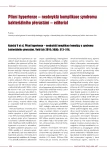Hyperlipoproteinemie a dyslipoproteinemie I.
Klasifikace, diagnostika, kardiovaskulární, kardiometabolické a reziduální riziko
Authors:
R. Češka; M. Kvasilová; R. Procházková; G. Šmelková; M. Vráblík
Authors‘ workplace:
Centrum preventivní kardiologie III. interní kliniky 1. lékařské fakulty UK a VFN Praha, přednosta prof. MU Dr. Štěpán Svačina, DrSc., MBA
Published in:
Vnitř Lék 2010; 56(6): 526-531
Category:
65th Birthday - Petr Svacina, MD
Overview
Cardiovascular diseases remain the most important cause of death worldwide. The situation in the Czech Republic is one of the best when compared to the other countries of the former socialist block; on the other hand, we significantly lack behind when the comparison is made to south and southwest European countries. The concept of risk factors (RF) and multifactorial character of atherosclerosis as the main cause of cardiovascular diseases (CVD) is fully accepted at present. Hyperlipoproteinaemia (HLP) and dyslipidemia (DLP) are a group of high incidence metabolic diseases characterised by increased levels of lipids and lipoproteins in plasma or, in case of DLP, by unsuitable, atherogenic composition of lipids and lipoproteins in plasma. HLP and DLP are among the most important RF for the development of CVD. Mainly LDL‑cholesterol (LDL‑C) is perceived as a very important risk factor; successful reduction of LDL‑C is linked to a reduction in cardiovascular risk. Even when LDL‑C is decreased and the so - called “target values” achieved, patients are still at risk of a CV event. This remnant risk is the so called “residual risk”. The most important “rival” to LDL‑cholesterol among the risk factors is the metabolic syndrome, or rather the DLP associated with the metabolic syndrome, characterised from the perspective of DLP by low levels of HDL‑cholesterol and increased triglycerides with concurrent occurrence of “small dense LDL”. The issue of heterogeneity and atherogenicity of lipoprotein particles in general then becomes topical. Lipoprotein (a) – Lp(a) is another important lipid risk factor that is getting a significant attention.
Key words:
hypercholesterolaemia – LDL‑cholesterol – metabolic syndrome – HDL‑cholesterol – hypertriglyceridaemia – heterogeneity of lipoprotein particles – residual risk – Lp(a)
Sources
1. Kastelein JJ, van Leuven SI, Burgess L et al. Effect of torcetrapib on carotid atherosclerosis in familial hypercholesterolemia. N Engl J Med 2007; 356 : 1620 – 1630.
2. Mazzone T. HDL cholesterol and atherosclerosis. Lancet 2007; 370 : 107 – 108.
3. Clarke R, Peden JF, Hopewell JC et al. Genetic variants associated with Lp(a) lipoprotein level and coronary disease. N Engl J Med 2009; 361 : 2518 – 2528.
4. ADA, NHLBI, AHA et al. Diabetes mellitus: A major risk factor for cardiovascular disease. Circulation 1999; 100 : 1132 – 1133.
5. O’Keefe JH Jr, Miles JM, Harris WH et al. Improving the adverse cardiovascular prognosis of type 2 diabetes. Mayo Clin Proc 1999; 74 : 171 – 180.
6. Češka R. Cholesterol a ateroskleróza. Léčba dyslipidémií. Praha: Triton 2005.
7. Shepherd J. Combined lipid lowering drug therapy for the effective treatment of hypercholesterolemia. Eur Heart J 2003; 24 : 685 – 689.
8. Brousseau ME, Schaefer EJ, Wolfe ML et al. Effects of an inhibitor of cholesteryl ester transfer protein in HDL cholesterol. N Engl J Med 2004; 350 : 1505 – 1515.
9. Mazzone T. HDL cholesterol and atherosclerosis. Lancet 2007; 370 : 107 – 108.
10. Qin S, Koga T, Ganji SH et al. Rosuvastatin selectively stimulates apolipoprotein A ‑ I but not apolipoprotein A ‑ II synthesis in Hep G2 cells. Metabolism 2008; 57 : 973 – 979.
11. Ballantyne C, Raichlen JS, Nicholls SJ et al. Effect of rosuvastatin therapy on coronary artery stenoses assessed by quantitative coronary angiography: a study to evaluate the effect of rosuvastatin on intravascular ultrasound ‑ derived coronary atheroma burden. Circulation 2008; 117 : 2458 – 2466.12. Robins SJ, Collins D, Wittes JT et al. Relation of gemfibrozil treatment and lipid levels with major coronary events. VA ‑ HIT: a randomized controlled trial. JAMA 2001; 285 : 1585 – 1591.
13. Jones PH, Davidson MH, Stein EA et al. Comparison of the efficacy and safety of rosuvastatin versus atorvastatin, simvastatin and pravastatin across doses (STELLAR Trial). Am J Cardiol 2003; 93 : 152 – 160.
14. Law MR, Wald NJ, Rudnicka AR. Quantifying effect of statins on low density lipoprotein cholesterol, ischaemic heart disease and stroke: systematic review and meta‑analysis. BMJ 2003; 326 : 1423.
15. Sacks FM. Low ‑ density lipoprotein lowering therapy: an analysis of the options. J Am Coll Cardiol 2002; 40 : 2135 – 2138.
16. Shepherd J. Combined lipid lowering drug therapy for the effective treatment of hypercholesterolemia. Eur Heart J 2003; 24 : 685 – 689.
17. Davidson MH, McGarry T, Bettis R et al. Ezetimibe coadministered with simvastatin in patients with primary hypercholesterolemia. J Am Coll Cardiol 2002; 40 : 2125 – 2134.
18. Keating GM, Robinson DM. Rosuvastatin: a review of its effect on atherosclerosis. Am J Cardiovasc Drugs 2008; 8 : 127 – 146.
19. Fruchart JC, Sacks F, Hermans MP et al. Residual Risk Reduction Initiative (R3i). The Residual Risk Reduction Initiative: a call to action to reduce residual vascular risk in patients with dyslipidemia. Am J Cardiol 2008; 102 (Suppl 10): 1K – 34K.
20. Fruchart JC, Sacks F, Hermans MP et al. Residual Risk Reduction Initiative (R3i). The Residual Risk Reduction Initiative: a call to action to reduce residual vascular risk in dyslipidaemic patient. Diab Vasc Dis Res 2008; 5 : 319 – 325.
Labels
Diabetology Endocrinology Internal medicineArticle was published in
Internal Medicine

2010 Issue 6
Most read in this issue
- Sepsis and the septic shock in oncological or other immunocompromised patients
-
Hyperlipoproteinemie a dyslipoproteinemie I.
Klasifikace, diagnostika, kardiovaskulární, kardiometabolické a reziduální riziko - Essential thrombocythaemia and other myeloproliferative disorders with thrombocythaemia treated with Thromboreductin. A report from the database of Register for the 1st quarter of 2010
- Different courses of recurrent or multisystem Langerhans cells histiocytosis in adults – description of 22 cases from one centre
